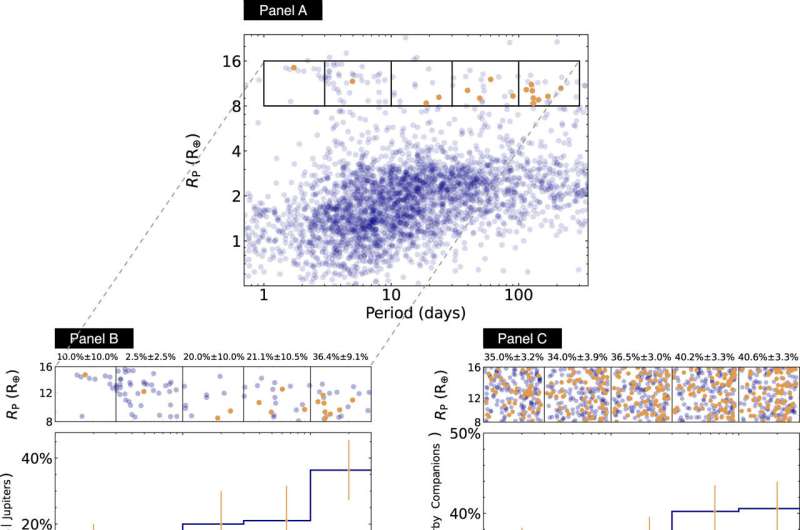This article has been reviewed according to Science X's editorial process and policies. Editors have highlighted the following attributes while ensuring the content's credibility:
fact-checked
peer-reviewed publication
trusted source
proofread
'Hot Jupiters' may not be orbiting alone

Research led by an Indiana University astronomer challenges longstanding beliefs about the isolation of "hot Jupiters" and proposes a new mechanism for understanding the exoplanets' evolution.
While our Jupiter is far away from the sun, hot Jupiters are gas giant planets that closely orbit stars outside our solar system for an orbital period of less than 10 days. Previous studies suggested they rarely have any nearby companion planets, leading scientists to believe that hot Jupiters formed and evolved through a violent process that expelled other planets from the area as they moved closer to their host stars. The research team's findings reveal that hot Jupiters do not always orbit alone.
"Our research shows that at least a fraction of hot Jupiters cannot form through a violent process," said Songhu Wang, assistant professor of astronomy in the College of Arts and Sciences. "This is a significant contribution to advance our understanding of hot Jupiter formation, which can help us learn more about our own solar system."
The study has been published in The Astronomical Journal, and Wang presented the results of the research at the June 2023 meeting of the American Astronomical Society in Albuquerque, New Mexico.
Researchers analyzed the full, four-year data set for hot and warm Jupiters from NASA's Kepler Mission. Warm Jupiters have a longer orbital period that ranges from 10 to 300 days. Researchers used transit timing variations to determine that at least 12% of hot Jupiters and 70% of warm Jupiters have a nearby planetary companion orbiting their host stars.
Wang and his collaborators combined their results with existing observational constraints to propose a new framework for explaining the evolution of hot and warm Jupiters and why some have companion planets. They determined that the makeup of hot and warm Jupiter systems depends on the occurrence of gas giants in the system, which impacts how much the planets interact and migrate.
The findings provide a launching point into future research about exoplanets and our solar system's planets.
"The ultimate goal for astronomers is to set our solar system into the bigger picture—'Are we unique?'" Wang said. "This helps us to understand why we don't have a hot Jupiter in our solar system."
Additional collaborators are Dong-Hong Wu, lecturer in the Department of Physics at Anhui Normal University, and Malena Rice, 51 Pegasi b Fellow at the Massachusetts Institute of Technology and incoming professor at Yale University.
Wang has long been interested in the configurations and demographics of exoplanets. He uses observational research to try to understand their dynamics and origins, helping astronomers better understand how our solar system fits into a larger cosmic context.
More information: Dong-Hong Wu et al, Evidence for Hidden Nearby Companions to Hot Jupiters, The Astronomical Journal (2023). DOI: 10.3847/1538-3881/acbf3f
Journal information: Astronomical Journal
Provided by Indiana University




















